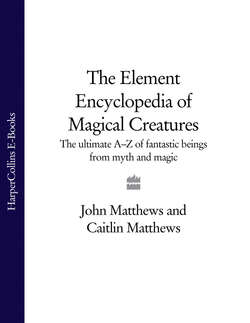Читать книгу The Element Encyclopedia of Magical Creatures: The Ultimate A–Z of Fantastic Beings from Myth and Magic - John Matthews - Страница 324
CAT
ОглавлениеCats have walked among us and lived around us for millennia. The big cats still walk by themselves and are given a wide berth by those who have cause to fear their depredations, but the domestic cat remains our constant companion as both pet and exterminator of vermin. The relationship between cats and humans is often seen as both opportunistic and helpful, enabling the cat generally to be the one who benefits most.
Cats have been central to myth and legend. The Egyptian cat cult based at Bubastis, where Bastet’s shrine was to be found, derives from the myth of the great jungle cat which cuts off the head of the serpent Apophis that tried to strangle the sacred persea tree. It was death to kill a cat in such a culture of cat reverence, for they were regarded as being the living exemplars of Bastet. If the cat of the household died, it was customary for the householder to shave off his eyebrows and to mummify the cat’s body with the same care and respect as would be shown to a human body. If your house was on fire, it would have been wise to rescue your cat before retrieving any possessions.
Cats also had divine duties in ancient Thailand where Siamese cats were the traditional guardians of temples and palaces. The original Siamese breed had a bent tail and crossed-eyes – features which have now been bred out of the animal – but which were said to come about because the cat concentrated so hard upon the object of its guardianship, wrapping its tail about the object to protect it. Further east, in China, the cat is seen as a shapeshifter. It is understood to be under a curse for not having wept when Buddha died. For the Japanese, the cat, together with the fox and badger, is associated with shapeshifting, trickery and the power to subdue ghosts and vampires. Japanese sailors keep one on board to protect them from sea monsters and ghosts. The Ainu of northern Japan believe that cats bring misfortune because they came from the ashes of a demon who was defeated by the mole god. Other Ainu stories tell how the cat was created to chase the rats who bit off the devil’s tongue. Both legends give reason why people should be careful around cats, since they had demonic origin.
This demonic connection is also found among the Zoroastrians who take the perceived division between cats and dogs into a wholly more serious area of debate. They believe that dogs are the animals belonging to Ormuzd, defender of all good, while cats are the animals beloved of Ahriman, the prosecutor of all evil. In Persian tradition, nearly all the false gods are depicted with a cat’s head. But in Muslim belief, it is the dog that is outcast and cursed, and the cat that is respected for it received a blessing from the prophet Mohammed.
Among the Romans, the cat was the companion of the goddess of liberty and, as a creature which can exhibit both complete relaxation and lascivious freedom, a symbol for the throwing off of all restraint. In Scandinavian tradition, cats pulled the chariot of the Norse goddess, Freya. In Celtic tradition, the cat often shows its troubling and punitive nature. In the Irish Voyage of Maelduin, the sailors enter a great treasury which is guarded by a cat leaping from pillar to pillar. The gold and jewels prove too great a temptation for one of Maelduin’s sailors, who puts a piece of jewellery under his shirt intending to steal it, but before he is able to step over the threshold and escape, the cat transforms itself into an avenging bolt of flame that instantly incinerates the thief. Celtic myth has many stories about supernatural or primordial cats, as we see from Cat Sith and Cath Palug.
In American Indian myth, the younger brother of Coyote is Wild Cat who is the patron of stealth and scouting. But the Tiger Cat or Cat-a-Mountain is a symbol of fierceness and ingratitude. In Peru, the cat Ccoa is the spirit of the storm; hail rains from the eyes and ears of its huge head. Also in South America, in Chile, lives Guirivulu, a cat-monster who has a tail that ends with a claw. It lives in deep pools and uses its claw to drag prey into the water.
Under Christian influence, the cat became increasingly associated with lack of restraint and eventually with the devil. The cat became the primary animal familiar of the witch, a sign that the cat’s owner was up to no good. This hostility to cats resulted in the death of many innocent animals – as well as their owners – when sacks of cats were thrown upon pyres to purge the devil from the community. Cat superstitions are widespread. For instance: Sailors take care not to use the word cat when they are at sea; what you say in front of a cat will not necessary remain a secret; a black cat that crosses your path will bring you luck.
Rudyard Kipling’s story of The Cat Who Walked By Itself, reminds us of the ironic independent dependence of the domestic cat upon its chosen family, whereas Lewis Carroll’s Cheshire Cat in Alice in Wonderland, depicts the enigmatic wisdom and seemingly random nature of cat affection.
